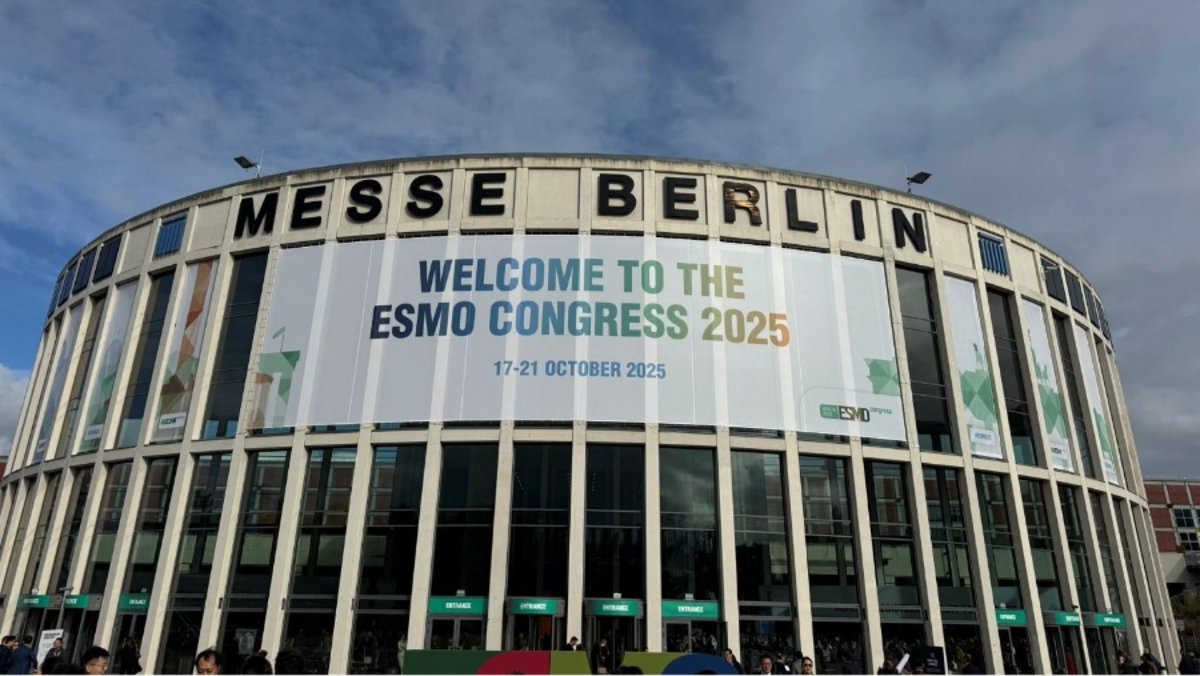
Our healthcare team was on the ground at the European Society for Medical Oncology (ESMO) Congress 2025, connecting with clients, industry leaders, and peers to stay at the forefront of cancer innovation. In this blog, Joe Milner, Associate Director, Health UK at Porter Novelli, shares his perspective from Berlin.
Five days at ESMO 2025 through a communicator’s lens
Last weekend, I attended the ESMO congress in Berlin, one of the world’s largest cancer conferences. Over five days at Messe Berlin, over 35,000 cancer experts gathered to share the latest advances in cancer treatment and care. For people like me working in pharmaceutical communications, these events are where the future of cancer care comes into focus, and where our job really begins.
On top of the work our clients pay us to do at ESMO, events like this present a golden opportunity to listen, learn, and think about how we can help translate the latest science into stories. Walking through the exhibition halls, sitting in on various presentations, and talking with researchers, I’m asking myself: how could we communicate these advances in a way that’s meaningful? How do we convey genuine progress without overpromising? It’s a balance we strike every day in this line of work.
So, what caught my attention as the best stories of ESMO 2025?
The rise of AI in cancer care
For me, perhaps the most interesting development being discussed was the integration of AI into cancer treatment decisions. No, oncologists are not being replaced by robots – quite the opposite. But AI is becoming an invaluable assistant, helping them predict which patients will respond best to which treatments.
Traditionally, oncologists have relied on their expertise and clinical guidelines to determine treatment. But in 2025, AI can analyze medical images and patient data to predict treatment responses with remarkable accuracy. One study presented at ESMO demonstrated how AI could identify which colorectal cancer patients would benefit from adding immunotherapy to their treatment regimen. AI analyzed tissue samples and essentially said, “this patient will likely respond well,” or “this patient probably won’t benefit.”
The results were striking. Patients identified by AI as responsive to immunotherapy lived significantly longer. This is game-changing technology that could help spare patients from aggressive and ineffective treatments, while ensuring those who would benefit receive them promptly.
ADCs move upstream
Another breakthrough gaining increased momentum is a class of treatments called antibody-drug conjugates, or ADCs. Think of them as biological missiles for cancer cells. These powerful therapies – normally prescribed alongside immunotherapy – combine targeting precision with powerful cancer-fighting agents, delivering treatment directly where it’s needed while minimizing damage to healthy tissue.
The real shift happening is that these treatments are moving upstream – no longer reserved just for advanced cancer. Multiple studies at ESMO demonstrated promising results in earlier-stage disease across breast, bladder, and lung cancers. Intervening with these powerful therapies earlier in a patient’s journey has the potential to change the trajectory of their cancer.
Cancer vaccines… about to have their moment?
After working with vaccines’ clients for most of my career, one area which has always fascinated me is cancer vaccines. While we’ve had important successes preventing virus-linked cancers with vaccines against human papillomavirus (HPV), progress with therapeutic vaccines for advanced cancers has been slow. However, after decades of disappointments and false starts, we’re finally seeing real momentum.
One study in advanced melanoma patients presented at ESMO, while not meeting its primary endpoint, showed patients receiving a cancer vaccine alongside immunotherapy nearly doubled their time without disease progression compared to standard treatment alone. As one researcher I spoke to noted, we might not be witnessing a single breakthrough moment, but rather the connecting of multiple scientific dots that collectively represent progress.
The science behind this is fascinating – these vaccines are personalized to each patient’s unique cancer, teaching their immune system to spot and destroy cancer cells based on their specific molecular makeup. It’s personalized medicine at its finest.
Coffee > pens
No matter how many millions pharmaceutical companies spend on flashy booths, everyone still loves a good freebie. And the free pen era is officially over; coffee is the new currency of congress exhibition halls.
After extensive (perhaps too extensive) field research, I can report that AstraZeneca claims the top spot for best ESMO coffee, an achievement I’m certain they value above their four major trial readouts. Merck and Astellas earn honorable mentions for their respectable brews.
Turning insights into impact
Flying back from Berlin, I’m struck by the gap between what happens in the congress hall and what reaches people in the real world. At ESMO, 35,000 experts discuss and (in some cases) applaud nuanced trial endpoints. Back home, patients and families are simply asking: what does this mean for me?
That’s where we communicators come in. Our job isn’t to hype every data point or oversimplify complex science. It’s to identify what genuinely matters, translate it honestly, and help people understand why even incremental progress is worth paying attention to.


